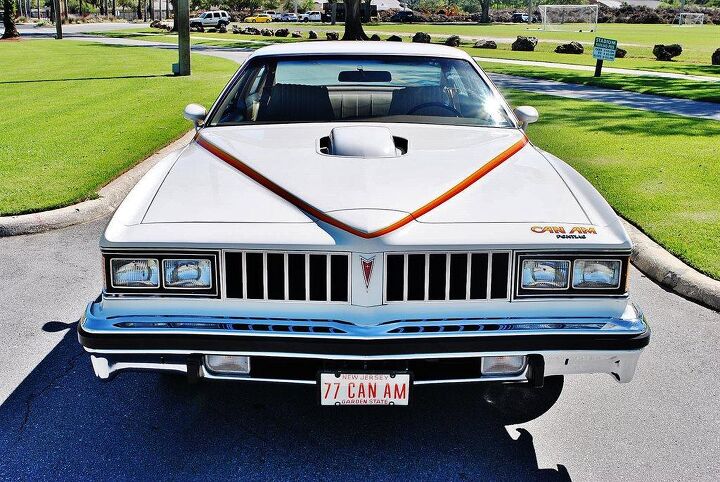Rare Rides: Aggressive Luxury With the 1977 Pontiac Can Am

Rare Rides reviews another Pontiac today. And much like the recently featured Bonneville, it’s large and in charge, from the Seventies, and has two doors. Let’s see how much horsepower the 1977 Can Am gained through stickers and spoilers.
The Can Am was one of the final developments of the fourth-generation Le Mans. A brand new car in 1973, the Le Mans used a new platform that still carried the title of A-body. Wheelbase remained unchanged at 112 inches for gen four, and many of the same engine options remained, as well. The exciting new Le Mans was available with power that ranged from a 250 cubic inch (4.1-liter) inline-six, through a 455 (7.5L) V8. Transmissions offered were three- and four-speed manuals, as well as a three-speed automatic. Given the world was still in the era of body style choice, Le Mans was available with two doors as a coupe, and four doors as a sedan and wagon.
Updates in 1974 brought the visage of Le Mans into the styling theme Pontiac would use through the entire Eighties (and into the Nineties). By 1977 the fourth-generation Le Mans was on its last legs; a downsizing in wheelbase, overall length, and engine displacement was imminent. Pontiac decided to develop a special edition at the last moment, introducing the ’77 Can Am at NAIAS in January of 1977.
Standard on this new special edition were the shaker scoop from the Trans Am and a 400 cubic inch (6.6L) engine. The 400 used was not the standard version, which made a strangled 180 horsepower, but rather the T/A W72. Said engine produced a more respectable 200 horsepower in those heady times. Pontiac shipped the W72 to 49 states, but customers in the Republic of California made do with an Oldsmobile 403 generating 185 horses.
Visually, all Can Ams were nearly identical. The only paint color available was Cameo White. Trim around windows was black instead of chrome, and there were black lower panels for a grounded to the ground look. Tape stripes of the flashy disco variety were added in orange, yellow, and red. On the shaker scoop, “T/A 6.6” was found on 49-state cars, and California versions read “6.6 LITRE” to make customers feel inadequate. The three-speed automatic was the only transmission fitted.
All Can Ams had a unique fiberglass spoiler not found on any other Pontiac. Color-key rally wheels were fitted as standard, but Trans Am snowflakes were optional. Also optional was the sunroof, which could be fitted in metal or glass. Inside, things were a bit more upscale than a typical Le Mans, as Can Am used the dashboard from a Grand Prix. Interior colors were standard Le Mans fare.
The process to turn a Le Mans into a Can Am occurred at Jim Wangers’ Motortown, where Mr. Wangers fitted the trim and distributed finished cars to dealers. Upon introduction, the Can Am was an immediate success. Though General Motors planned to make 2,500, they received more than double that in orders. But disaster struck! After six months and 1,133 Can Ams, the mold Motortown used to fabricate the rear spoiler was ruined. General Motors quickly decided to… can the project. Some Pontiac executives were never fond of the Can Am anyway, as they felt its use of the Grand Prix dashboard cannibalized sales from the more expensive model. A quick blip on the radar, and Can Am was gone.
Today’s Rare Ride was sold via a Florida dealer recently for an undisclosed sum. It was in fantastic condition, with 16,000 miles.
[Images: seller]

Interested in lots of cars and their various historical contexts. Started writing articles for TTAC in late 2016, when my first posts were QOTDs. From there I started a few new series like Rare Rides, Buy/Drive/Burn, Abandoned History, and most recently Rare Rides Icons. Operating from a home base in Cincinnati, Ohio, a relative auto journalist dead zone. Many of my articles are prompted by something I'll see on social media that sparks my interest and causes me to research. Finding articles and information from the early days of the internet and beyond that covers the little details lost to time: trim packages, color and wheel choices, interior fabrics. Beyond those, I'm fascinated by automotive industry experiments, both failures and successes. Lately I've taken an interest in AI, and generating "what if" type images for car models long dead. Reincarnating a modern Toyota Paseo, Lincoln Mark IX, or Isuzu Trooper through a text prompt is fun. Fun to post them on Twitter too, and watch people overreact. To that end, the social media I use most is Twitter, @CoreyLewis86. I also contribute pieces for Forbes Wheels and Forbes Home.
More by Corey Lewis
Latest Car Reviews
Read moreLatest Product Reviews
Read moreRecent Comments
- Cprescott Doesn't any better in red than it did in white. Looks like an even uglier Honduh Civic 2 door with a hideous front end (and that is saying something about a Honduh).
- Kwik_Shift_Pro4X Nice look, but too short.
- EBFlex Considering Ford assured us the fake lightning was profitable at under $40k, I’d imagine these new EVs will start at $20k.
- Fahrvergnugen cannot remember the last time i cared about a new bmw.
- Analoggrotto More useless articles.








































Comments
Join the conversation
T/A 6.6 was decent engine---for the times. Those 70's cars ran much better when you pulled the catalytic converter off and ran real dual exhausts.
One of the houses on my paper route had one of these new. Was a nice change from the hideous orange/black '74 AMC Matador coupe (Barcelona Edition). I guess it was foreshadowing... about 5-6 years later, I had a '78 Pontiac Grand LeMans... two-tone cream & bronze, factory mags, velour interior... loved that car... had 236,000 miles on it when I sold it in 1991... still looked & ran great...